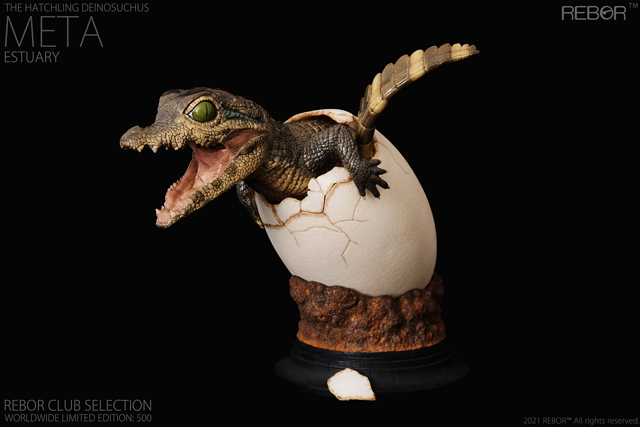Ancient Crocodile Poop Provides Evidence of Deinosuchus Diet
New Study into Fossilised Crocodile Poop Provides Evidence of Deinosuchus Diet
It was not just the tyrannosaurs and raptors that the unwary dinosaur herbivore had to look out for in the Late Cretaceous habitats of the southern and southwestern United States seventy million years ago. In estuarine environments (where rivers meet the sea), there lurked a monster crocodile called Deinosuchus that would have quite happily tackled a duck-billed dinosaur or pachycephalosaur had one ventured too near.
Deinosuchus
That is the conclusion drawn by a team of U.S. based scientists following a study of ancient crocodile coprolite (fossilised poop). The coprolite, some of which measures more than 13 cm long, has been assigned to the fearsome Late Cretaceous predator Deinosuchus and evidence from the study of such objects has helped scientists determine the diet of this huge reptile and where it lived.
Deinosuchus (Deinosuchus hatcheri) was a huge, crocodilian that lived in what was North America during the later stages of the Cretaceous period. Although, no complete skeleton has been found, a number of fragmentary fossils and a nearly complete skull have been discovered. Scientifically named in 1909, this huge reptile has been estimated to have reached lengths in excess of 10 metres and would have weighed perhaps as much as 2 tonnes. A recent study has indicated that Deinosuchus (the name means “terrible crocodile”) may actually be more closely related to modern alligators than crocodiles.
A Replica of a Hatching Deinosuchus

The Rebor Club Selection: Meta the hatchling Deinosuchus is about to leave its egg! It’s very keen to get to the safety of the water.
Picture credit: Everything Dinosaur
The picture (above) shows the Rebor limited-edition hatching Deinosuchus (Esturary variant).
To view the range of Rebor figures and models: Rebor Prehistoric Animal Figures.
Estimating the Size of Deinosuchus
It is difficult to provide an accurate estimate of the size of this particular ancient crocodile in the absence of more complete skeletal material. Using ratio measurements of skull length compared to body size of modern crocodiles as a guide, an estimated size of between 10-12 metres can be obtained.
Professor David Schwimmer of Columbus State University and one of his students of palaeontology, Samantha Harrell; carried out a detailed analysis of the fossilised crocodile dung and bones that showed bite marks from crocodilians. They have concluded that this fearsome beast preferred to live in shallow, estuarine environments and preyed mainly on sea turtles but would have also been capable of taking down a dinosaur or two.
Palaeontologist Professor Schwimmer (no relation to the actor who played Ross the palaeontologist in “Friends”) stated:
“We’re sure [Deinosuchus] ate a lot of sea turtles, but it’s evident it liked to prey on dinosaurs too.”
Professor Schwimmer and Harrell gave a combined presentation on the bite marks and the coprolites, at the March 13-16 Geological Society of America Northeastern/South-eastern annual meeting in Baltimore. Additionally, the coprolite study is being published as “Coprolites of Deinosuchus and other Crocodylians from the Upper Cretaceous of Western Georgia, USA” in a special symposium volume of the New Mexico Museum of Natural History and Science Bulletin.
Bite Marks on Dinosaur Bones
The studies detail how bite marks on dinosaur bones discovered in various locations around the United States, and large fossilised dung droppings discovered near Columbus, Georgia (southern USA), have been linked to Deinosuchus.
The dung fossils are the first such documented samples from the Deinosuchus and help confirm that this giant, prehistoric crocodile preferred living in the marine shallows. Meanwhile, the separate bite mark findings reveal aspects of the creature’s eating habits.
In the spring of 2009, Professor Schwimmer asked Harrell to take command of a project as an independent study course to gather and analyse fossilised dung he had started to recover from a fossil hot spot along the banks of the Hannahatchee Creek in Stewart County, a major tributary of the Chattahoochee River, south of where the Piedmont meets the Coastal Plain.
Harrell explained coprolites are studied in order to convey information about the lifestyles of the dead and buried. She discovered sand and lots of shell fragments, signifying that these crocodiles lived in a shallow, brackish, warm-water environment — likely near the mouth of a river where it opened to a sea with a sandy shoreline and an abundance of sea turtles for its diet.
Although it is difficult to be absolutely precise when assigning fossilised dung to a particular genus, in this case the size, shape and nature of the dung studied does indicate a large crocodile and Deinosuchus is the only known genus of crocodile from this strata.
To view models of prehistoric crocodiles: Wild Safari Prehistoric World Models and Figures.

